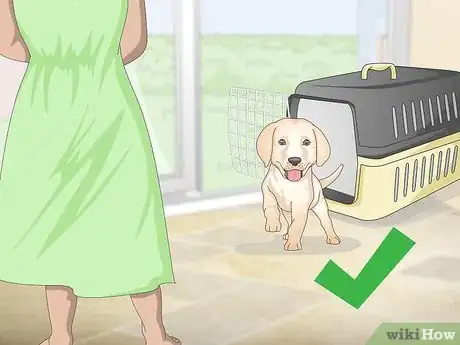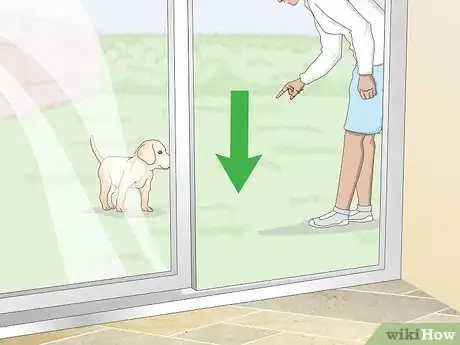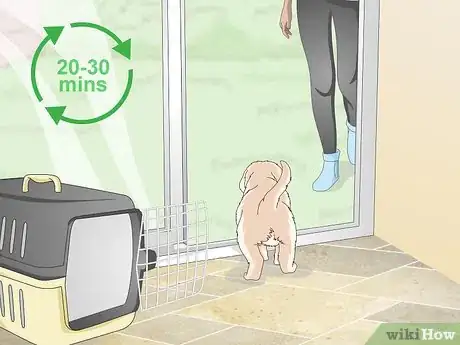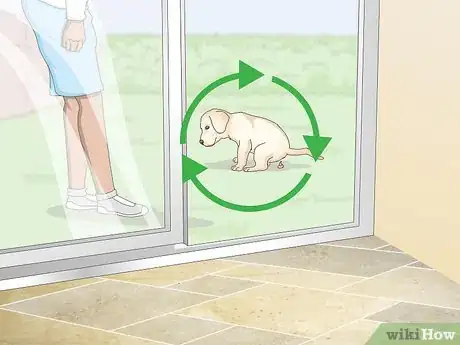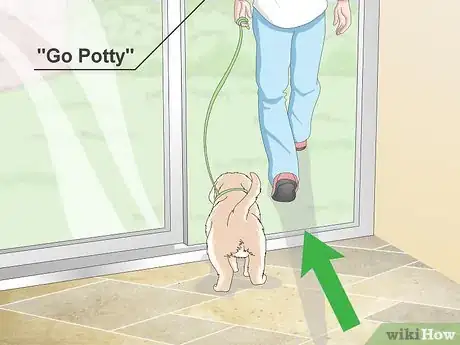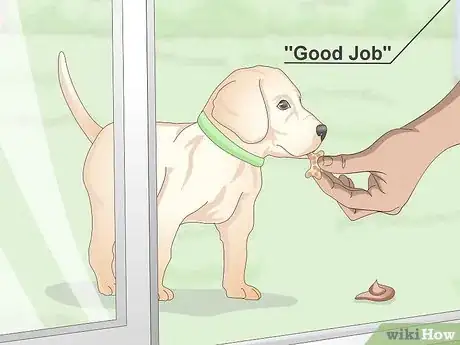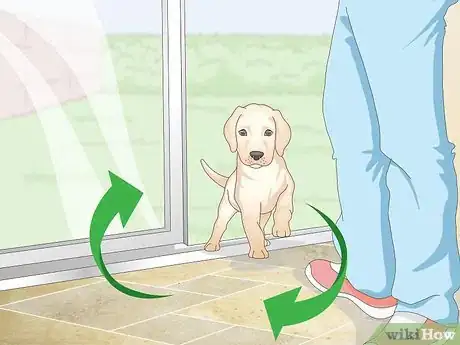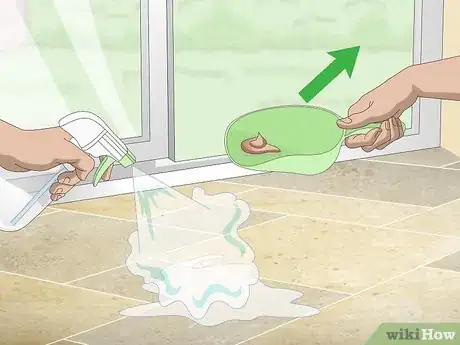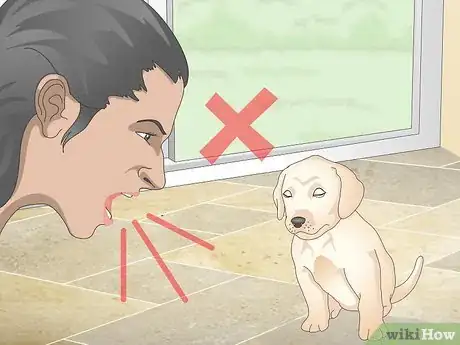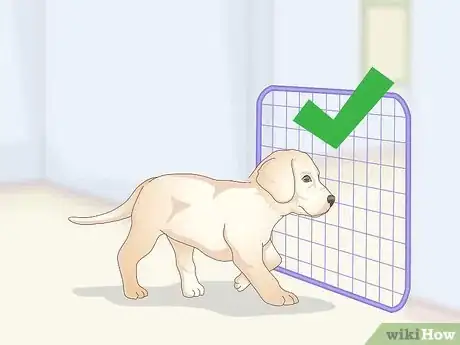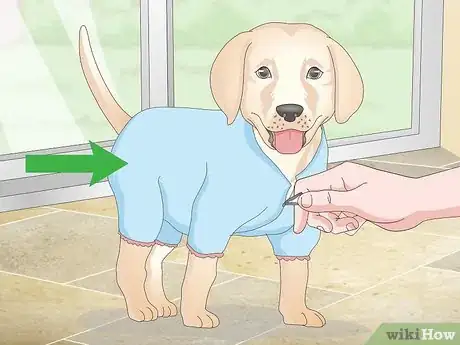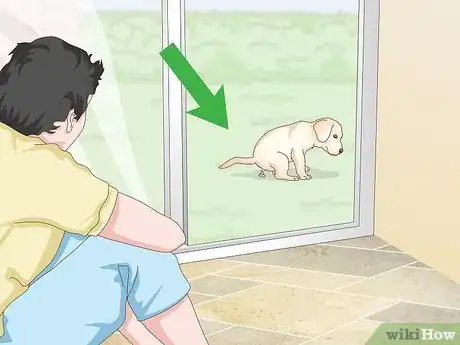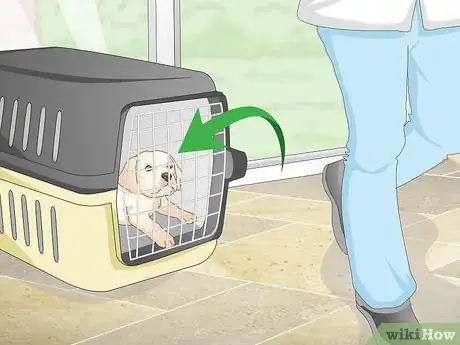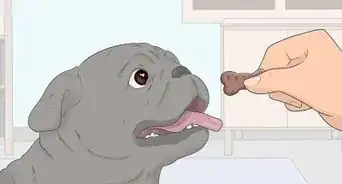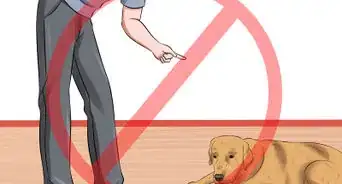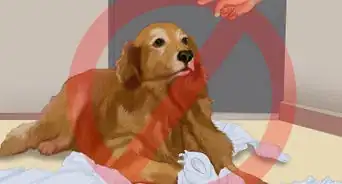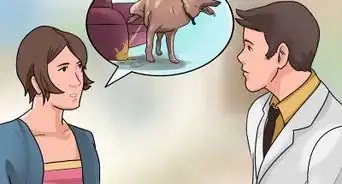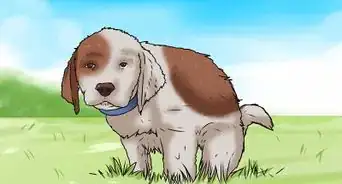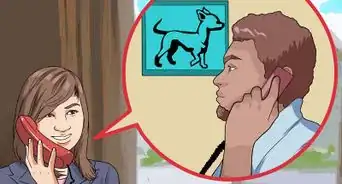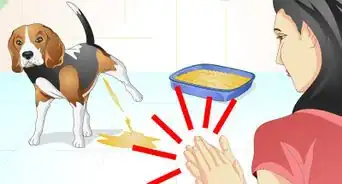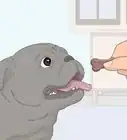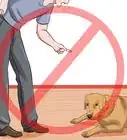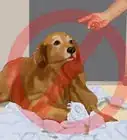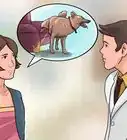This article was co-authored by David Levin and by wikiHow staff writer, Jessica Gibson. David Levin is the Owner of Citizen Hound, a professional dog walking business based in the San Francisco Bay Area. With over 9 years of professional dog walking and training experience, David's business has been voted the "Best Dog Walker SF" by Beast of the Bay for 2019, 2018, and 2017. Citizen Hound has also been ranked #1 Dog Walker by the SF Examiner and A-List in 2017, 2016, 2015. Citizen Hound prides themselves on their customer service, care, skill, and reputation.
There are 9 references cited in this article, which can be found at the bottom of the page.
This article has been viewed 41,214 times.
If your small dog is proving to be a challenge to potty train, start it on a simple routine. Since small dogs have small bladders, frequently take your dog outside to a designated space. Encourage it to toilet using command words and reward it with verbal praise or treats when it successfully goes. Be consistent in your expectations and your dog will soon get the hang of toileting in the appropriate place.
Steps
Establishing a Routine
-
1Start potty training as soon as you can. If you're bringing the new dog home, ensure that you're ready to begin training immediately. The sooner your small dog associates toileting with the appropriate space, the easier it will be to train it.[1]
- Keep in mind that all breeds are different and your small dog is an individual. Some dogs pick up potty training quickly while others need more practice.
- If your dog is still a puppy, you can start the training process right away, but remember that puppies under 8 weeks old have poor bladder control and won't be able to get it down perfectly until they're older.
-
2Choose a designated place to toilet. Pick a place outside where you'd like your small dog to go. When you take your dog outside, walk it right to the spot. Avoid letting it wander around or run off when it's time to toilet.[2]
- Be in the habit of letting the dog toilet first thing when you go outside. Then let your dog go for a walk or play once it's finished.
Advertisement -
3Make potty breaks part of the daily schedule. If your small dog is still a puppy, you'll need to take it to the toilet spot every 20-30 minutes, which gives your puppy a better chance of being in the toilet spot at the right time.[3] If your small dog is an adult, plan on taking your dog outside at regular intervals throughout the day. For example, give your small dog the chance to toilet:[4]
- First thing in the morning
- Right before bed at night
- After being in a crate
- After meals or drinking
-
4Be consistent in your expectations. Dogs learn best by repetition, so stick with your toileting routine every day.[5] If you don't follow your own schedule, the dog will be confused and is more likely to have an accident.[6]
- For example, if you usually take your dog outside after meals, but forget to one day, your dog may have an accident because it's used to going at a set time.
Taking the Dog Out
-
1Lead your dog outside and say a command word such as "go potty." Keep your small puppy on a leash and walk it over to the place where you'd like it to toilet. Let it walk around the space for a bit. Once it starts to go, and say a word or phrase that they'll associate with the action. Later, you'll be able to say the cue word as a trigger; right now, you're still building the mental link.[7]
- For example, say, "do your business," or "go pee."
-
2Reward your dog with praise and food treats.[8] As soon as you see your dog successfully toileting in the right place, say the cue word, then give it lots of verbal praise such as "Good job!" or a small dog treat. Reward it immediately so it associates going in that place with good things.[9]
- If you're giving your small dog a treat, keep the treat small as well. The treat should be soft and pea-sized such as a bit of chicken or beef.
-
3Give your dog another chance if it doesn't toilet the first time. If you've taken your dog outside as part of your regular schedule but it didn't pee or poop, bring it back inside and put it in its crate. Keep it in the crate for 15 minutes and then take it back outside to try again. Continue to do this until the dog toilets.[10]
- This will help it understand that it has to toilet in that one space.
- If you don't have a crate, keep your dog leashed and tie the leash to your belt. Then take it outside after the 15 minutes are up.
-
4Clean up accidents to prevent your dog from toileting there again. When you notice that your small dog has had an accident, immediately stop and clean up the mess. Use a pet odor neutralizer spray and blot the mess.[11] It's important to remove the scent so your dog doesn't return to toilet there in the future.[12]
- If your dog has toiled on cushions, bedding, or blankets, add 1 pound (450 g) of baking soda to your laundry detergent. Wash the items and dry it completely. If you still smell urine, wash the items again with an enzymatic cleanser.
-
5Avoid yelling at your dog. Expect that mistakes will happen as your small dog learns to toilet in the appropriate place. Never yell or shout at your dog when this happens since dogs don't learn through punishment.[13]
- You should also avoid rubbing your dog's nose in its mess, striking the dog, or throwing things at it. These abusive actions will only frighten the dog and damage your relationship.[14]
Encouraging Your Small Dog
-
1Limit your dog's freedom inside the house until it's trained. If your small dog enjoys roaming throughout your house, it may find it easier to pick a spot in the house to toilet rather than go outside. Until it's potty trained, keep the dog in 1 or 2 rooms.[15]
- Confining your dog will also reduce the likelihood of accidents since it can't wander off and pee somewhere unexpected.
- Wait at least 1 month after your dog is potty trained before you open other rooms of your house to the dog.
-
2Make your dog comfortable with going outside. Small dogs may not like the going outside to toilet because it's cold or the grass feels strange. If you know it's cold outside, consider putting a sweater on your dog before you take it out. To help your dog get used to the texture of its toileting space, bring some of the material inside for it to check out.
- For example, bring a small patch of grass inside and set it in your dog's space for it to get used to.
-
3Supervise your dog during the potty training process. Your dog will need a lot of guidance until it learns to go outside to toilet. Stay with your dog and continue to give it lots of opportunities to go outside, especially if it shows signs that it needs to toilet. These signs include:[16]
- Whining
- Scratching at the door
- Pacing near your feet
- Following you around
-
4Crate your dog when you can't supervise it.[17] If you know you'll be gone for a while and can't watch your small dog in the house, put it in the crate. Keep in mind that your dog may have an accident in the crate if you're gone too long, so try not to leave your dog for more than a few hours until it's potty trained.[18]
- If you need to be gone for an extended period of time before your dog is trained, ask someone to watch the dog until you return.
Expert Q&A
-
QuestionWhat should I do to house train a smaller dog?
 David LevinDavid Levin is the Owner of Citizen Hound, a professional dog walking business based in the San Francisco Bay Area. With over 9 years of professional dog walking and training experience, David's business has been voted the "Best Dog Walker SF" by Beast of the Bay for 2019, 2018, and 2017. Citizen Hound has also been ranked #1 Dog Walker by the SF Examiner and A-List in 2017, 2016, 2015. Citizen Hound prides themselves on their customer service, care, skill, and reputation.
David LevinDavid Levin is the Owner of Citizen Hound, a professional dog walking business based in the San Francisco Bay Area. With over 9 years of professional dog walking and training experience, David's business has been voted the "Best Dog Walker SF" by Beast of the Bay for 2019, 2018, and 2017. Citizen Hound has also been ranked #1 Dog Walker by the SF Examiner and A-List in 2017, 2016, 2015. Citizen Hound prides themselves on their customer service, care, skill, and reputation.
Professional Dog Trainer Be sure you pay attention to your dog so you notice signs that it needs to go outside, like whining or pacing. Let your dog outside and encourage it to go potty. When they finish, reward your dog with praise or a treat so it keeps behaving.
Be sure you pay attention to your dog so you notice signs that it needs to go outside, like whining or pacing. Let your dog outside and encourage it to go potty. When they finish, reward your dog with praise or a treat so it keeps behaving. -
QuestionWhat do I use to train hypoallergenic dogs?
 Community AnswerHypoallergenic dogs are not any different from regular dogs when it comes to training. You can use commands, treats, and/or positive reinforcement to train your dog.
Community AnswerHypoallergenic dogs are not any different from regular dogs when it comes to training. You can use commands, treats, and/or positive reinforcement to train your dog. -
QuestionAre their different rules for different breeds of dog?
 Community AnswerThe way a dog learns doesn't tend to differ according to breed. However, the important thing to remember is that all dogs have different personalities and therefore learn differently as individuals. Just make sure to experiment in order to find out what method works best for your dog.
Community AnswerThe way a dog learns doesn't tend to differ according to breed. However, the important thing to remember is that all dogs have different personalities and therefore learn differently as individuals. Just make sure to experiment in order to find out what method works best for your dog.
Things You'll Need
- Leash
- Dog treats
- Pet odor neutralizer spray
- Cloths
- Baking soda and laundry detergent
- Crate, optional
References
- ↑ https://vcahospitals.com/know-your-pet/puppy-behavior-and-training-training-basics
- ↑ http://www.humanesociety.org/animals/dogs/tips/housetraining_puppies.html?credit=ad_gg_search_pettips_011316&gclid=Cj0KCQjwtb_bBRCFARIsAO5fVvEKl6qhGib0bFP8WCR11tcIvadZ3HXCqMkGxrYQLjshDscwDEJRtrMaAqY0EALw_wcB
- ↑ David Levin. Professional Dog Walker & Trainer. Expert Interview. 19 December 2019.
- ↑ https://lynchburghumane.org/services/pet-behavior-resources/
- ↑ David Levin. Professional Dog Walker & Trainer. Expert Interview. 19 December 2019.
- ↑ https://www.healthypawspetinsurance.com/blog/2016/01/23/puppy-potty-training-mistakes
- ↑ http://www.humanesociety.org/animals/dogs/tips/housetraining_puppies.html?credit=ad_gg_search_pettips_011316&gclid=Cj0KCQjwtb_bBRCFARIsAO5fVvEKl6qhGib0bFP8WCR11tcIvadZ3HXCqMkGxrYQLjshDscwDEJRtrMaAqY0EALw_wcB
- ↑ David Levin. Professional Dog Walker & Trainer. Expert Interview. 19 December 2019.
- ↑ http://www.humanesociety.org/animals/dogs/tips/dog_training_positive_reinforcement.html
- ↑ http://www.nehumanesociety.org/for-pet-owners/behavior-help/potty-training.html
- ↑ David Levin. Professional Dog Walker & Trainer. Expert Interview. 19 December 2019.
- ↑ http://www.humanesociety.org/animals/resources/tips/removing_pet_stains_odors.html#Prevent
- ↑ https://www.healthypawspetinsurance.com/blog/2016/01/23/puppy-potty-training-mistakes
- ↑ David Levin. Professional Dog Walker & Trainer. Expert Interview. 19 December 2019.
- ↑ https://www.quickanddirtytips.com/pets/dog-training/how-to-potty-train-a-small-dog-or-puppy-in-a-big-home
- ↑ http://www.humanesociety.org/animals/dogs/tips/housetraining_puppies.html?credit=ad_gg_search_pettips_011316&gclid=Cj0KCQjwtb_bBRCFARIsAO5fVvEKl6qhGib0bFP8WCR11tcIvadZ3HXCqMkGxrYQLjshDscwDEJRtrMaAqY0EALw_wcB
- ↑ David Levin. Professional Dog Walker & Trainer. Expert Interview. 19 December 2019.
- ↑ http://www.humanesociety.org/animals/dogs/tips/housetraining_puppies.html?credit=ad_gg_search_pettips_011316&gclid=Cj0KCQjwtb_bBRCFARIsAO5fVvEKl6qhGib0bFP8WCR11tcIvadZ3HXCqMkGxrYQLjshDscwDEJRtrMaAqY0EALw_wcB
